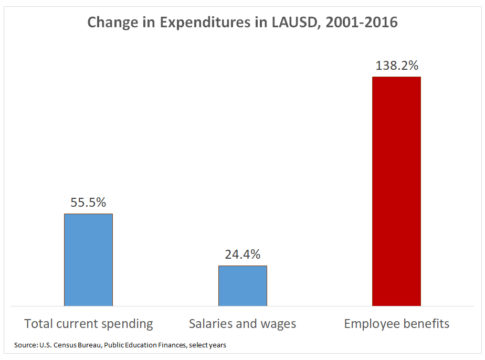It’s like the bad penny that keeps re-appearing, only it costs hundreds of millions of dollars. The constant reversion to calls for ever-smaller class sizes never seems to lose its appeal for the teacher unions or for school districts arguing for more funds.
The New York City union should, however, receive recognition for their imaginative new ploy – playing on populist sentiments to pay for yet further class size reduction mandates. The city teachers union has begun pushing a new property-tax proposal tied to its union employment program.
Everyone would be better off if they just stuck to teaching kids.
The union’s proposal, announced with great fanfare by UFT boss Michael Mulgrew, is to increase property-tax receipts by placing an added burden on housing owners who do not use their City apartment as their primary residence. The new revenues, which they estimate would add up to some $900 million, would then be used to fund a new low cap on class sizes in grades K-3.
The idea is getting Albany legislators to lower current class size restrictions, which are built into the union-negotiated contract — that is, using the Legislature to engineer new teacher hiring.
Of course, the unions do not have strong opinions on the specific tax used. Any tax will do, as long as it can funnel money into labor’s coffers. So instead of focusing on the levy itself, it is more useful to focus on the true objectives: lowering class sizes in order to hire many new (dues-paying) educators.
This is an idea whose time came, and went, many years ago. In the decade-and-a-half that has passed since the beginning of the class-size-reduction craze, virtually everybody concerned with student achievement has come to realize that further reductions are not a wise way to spend school money.
Let’s review the evidence. Support for class size reduction is always tracked back to a single experiment in the mid-1980s, Project STAR in Tennessee. While this was a poorly implemented experiment, it showed some achievement gains in small kindergartens.
Nobody has wanted to repeat that experiment for fear of a different answer. Nationwide, pupil-teacher ratios for the country fell from 17.8 in 1995 to 15.8 in 2008. With the recession, they rose back to 16.4 in 2010 — but this simply reflected the fact that this was the least harmful way to deal with the budget shortfalls. For New York City the equivalent 2010 number is 14.5. (While pupil-teacher ratios are not the same as class size, they indicate the teachers available to the school, regardless of how the school wishes to deploy them. They also track with class sizes in the schools.)
Nobody has shown that these substantial class-size reductions of the past 15 years have paid off in terms of student achievement.
Instead, the two main effects of past class-size reduction have been more teachers and more expensive schools.
Education research is essentially unanimous: The effectiveness of the teacher in the classroom is far, far more important than how many students are in the classroom. Class size reduction is the most expensive policy change typically proposed, and there is little doubt that funneling similar money toward recruiting and retaining effective teachers would be much more valuable.
But this is not the message that the union wants to hear, because it would involve evaluating teachers and making personnel decisions based on the quality of the work they do.
Interestingly, before calling for this new tax to reduce class size, the union was in Albany to stop any attempts to improve the evaluation of teachers.
There is now substantial evidence of the value of top teachers: They improve students’ skills and thereby boost their students’ labor market outcomes. Estimates by Raj Chetty, John Freidman, and Jonah Rockoff based on New York City teachers and students show that a top teacher can add a quarter of a million dollars to the future incomes across her class. And she does this every year.
Similar estimates that I have done show the other end of the picture. A bottom teacher subtracts a similar amount or more from her students.
The union, instead of acknowledging this, is currently engaged in two New York lawsuits involving tenure and dismissal statutes. They are resisting any change that might produce more thoughtful evaluation and retention decisions.
No estimates of the impacts of class size reduction suggest impacts anywhere near as large as those related to improving teacher quality.
This isn’t an education policy push by the union; it’s a political one. By going back to the tried-and-true rhetoric of class size reduction, the union would like to distract attention from any alternative school improvement policies.
– Eric Hanushek
Hanushek is a senior fellow at the Hoover Institution of Stanford University and the co-author of “Endangering Prosperity: A Global View of the American School.” An earlier version of this discussion appeared in the New York Daily News.



